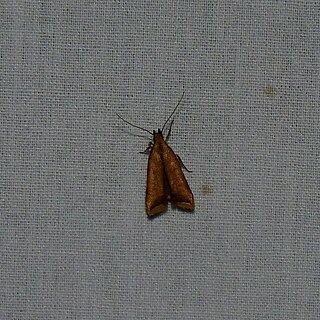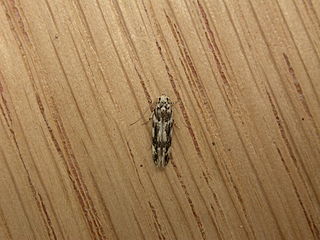
The Gelechiidae are a family of moths commonly referred to as twirler moths or gelechiid moths. They are the namesake family of the huge and little-studied superfamily Gelechioidea, and the family's taxonomy has been subject to considerable dispute. These are generally very small moths with narrow, fringed wings. The larvae of most species feed internally on various parts of their host plants, sometimes causing galls. Douglas-fir (Pseudotsuga) is a host plant common to many species of the family, particularly of the genus Chionodes, which as a result is more diverse in North America than usual for Gelechioidea.

Aroga is a genus of moths in the family Gelechiidae.

The black-edged dichomeris or black-edged carbatina is a moth of the family Gelechiidae. It is found in the north-eastern United States, Korea, Japan, China, Taiwan and India. It has also been recorded in the Netherlands, where it is an exotic species.

Aroga flavicomella is a moth of the family Gelechiidae. It is found in most of Europe, except Ireland, Great Britain, the Benelux, Denmark, Fennoscandia, the Baltic region, Portugal and the western and southern part of the Balkan Peninsula. It has also been recorded from Turkey, the Middle East, Mongolia, Korea and Central Asia, including Kyrgyzstan.

Dichomeridinae is a subfamily of moths in the family Gelechiidae.

Parachronistis albiceps, the wood groundling, is a moth of the family Gelechiidae. It is found in most of Europe, except the Iberian Peninsula and part of the Balkan Peninsula. Outside of Europe, it is found in southern Siberia, the Russian Far East and Korea.

Helcystogramma convolvuli, the sweet potato moth, sweetpotato webworm moth, sweetpotato leaf roller or black leaf folder, is a moth of the family Gelechiidae. It is mainly found in Asia and Africa, but there are also records from Oceania, the Middle East, the Caribbean and Florida in the United States. The species is also found on the Canary Islands and Madeira.

Carpatolechia fugitivella, the elm groundling, is a moth of the family Gelechiidae. It is found in almost all of Europe, Turkey, the Caucasus, Mongolia, southern Siberia, the Russian Far East and Korea. It is also found in Canada, where it has been recorded from Ontario and Quebec. The habitat consists of woodland, parks, gardens and hedgerows.
Dendrophilia mediofasciana is a moth of the family Gelechiidae. It was described by Kyu-Tek Park in 1991. It is found in Russia, Korea and Honshu, Japan.
Chionodes holosericella is a moth of the family Gelechiidae. It is found in Norway, Sweden, Finland, Latvia, Estonia, France, Germany, Austria, Italy, Croatia, Slovakia, Ukraine and Russia. Outside of Europe, it is found in the Caucasus, from Siberia to the Magadan Oblast and in South Korea.

Monochroa divisella, the scarce marsh neb, is a moth of the family Gelechiidae. It is found in Denmark, Latvia, Germany, the Netherlands, Belgium, Great Britain, the Czech Republic, Hungary, Bulgaria and France. Outside of Europe, it is known from Korea, the Russian Far East and Japan. The habitat consists of fens, marshes, river-banks and other damp areas.

Gelechia rhombella, the apple groundling, is a moth of the family Gelechiidae. It is found in Europe, the Caucasus, Transcaucasia, southern Siberia, the Russian Far East, Korea and China.

Psoricoptera gibbosella, the humped crest, is a moth of the family Gelechiidae. It is widely distributed in Europe. Outside of Europe, it is found in Turkey, North Africa, China, Japan, Korea, Siberia and the Russian Far East. The habitat consists of mature woodlands.
Dichomeris bulawskii is a moth in the family Gelechiidae. It was described by Ponomarenko and Park in 1996. It is found in south-eastern Siberia.
Dichomeris synergastis is a moth in the family Gelechiidae. It was described by Ponomarenko and Park in 1996. It is found in Korea.
Dichomeris lutilinea is a moth in the family Gelechiidae. It was described by Ponomarenko and Park in 1996. It is found in Korea.
Bagdadia salicicola is a moth in the family Gelechiidae. It was described by Kyu-Tek Park in 1995. It is found in Taiwan, Japan and Hainan, China.
Anarsia bimaculata is a moth in the family Gelechiidae. It was described by Ponomarenko in 1989. It is found in Japan, Korea, the Russian Far East (Primorye) and China (Jilin).
Pseudotelphusa acrobrunella is a moth of the family Gelechiidae. It is found in Korea, Japan and the Russian Far East.

Eulamprotes atrella, the two-spotted neb, is a moth of the family Gelechiidae. It was described by Michael Denis and Ignaz Schiffermüller in 1775. It is found from most of Europe, east to Japan. The habitat consists of mixed deciduous woodlands.










